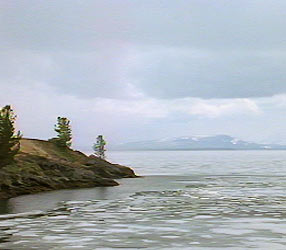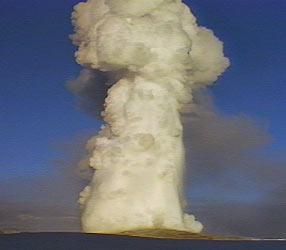
Hot springs lie beneath Yellowstone Lake
Yellowstone National Park, established in 1872, is a geothermal landmark. This unique environment has a built-in heating system that melts ice floes, keeping rivers and lakes from freezing completely, even in the middle of winter. At Yellowstone, winter effectively lasts from September to April, but hot springs underneath 320-foot-deep Yellowstone Lake keep ice from covering up some of it, so that resident otters can find places to fish even in the coldest weather.
While much of the park’s 2.2 million acres freezes in the cold months, the geothermal activity near the center of the park creates an unusually temperate atmosphere for wildlife. In the dead of winter, bison can be seen grazing near the park’s geysers, which remain clear of snow and ice.
However, danger lurks underfoot. In many places, the ground at Yellowstone is but a thin crust of earth stretched over a scalding hot spring. If a bison wanders too close to the mouth of a geyser, its two tons of weight may break through the ground, plunging the animal into a 175-degree underground pool. No scientist completely understands the underground plumbing system here; it is simply too hot to explore at close range.

Old Faithful erupts once every 80 minutes.
Yellowstone may seem otherwordly, but its geological mysteries are easily explained. Under a thin crust, our planet is a ball of molten rock. At Yellowstone, this crust is extremely thin — the molten rock is only three miles down from the surface.
When surface water seeps down and meets the molten rock’s heat, geothermal activity occurs, in the form of hot springs, mud pots, and geysers. Hot springs, or thermal pools, can exist in outrageous colors, from orange to blue to black, depending on the minerals present. Mud pots, which result when scalding water mixes with clay, also vary in color — for this reason, they are sometimes called “paint pots.”
Geysers are common at Yellowstone; between 150 and 200 dot the park. When the build-up of hot water under the surface causes unbearable pressure, a geyser shoots upward in an explosion of steam. Some erupt as often as two minutes; “Old Faithful,” a geyser that keeps a famously regular schedule, is one of the United States’ best-known tourist attractions.









